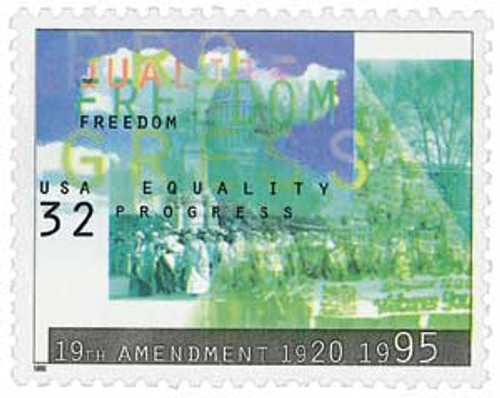
# 2980 - 1995 32c Women's Suffrage
U.S. #2980
1995 Woman Suffrage
- 75-year anniversary of the 19th Amendment to the US Constitution
Stamp Category: Commemorative
Value: 32¢
First Day of Issue: August 26, 1995
First Day City: Washington, DC
Quantity Issued: 105,000,000
Printed by: Ashton-Potter
Printing Method: Offset 160 subjects (10 across, 16 around). Intaglio printing plates of 160 subjects (10 across, 16 around).
Format: Panes of 20, horizontal – 5 across and 8 down.
Perforations: 11.1 x 10.9
Why the stamp was issued: The stamp was issued to commemorate the 75th anniversary of the 19th Amendment to the US Constitution.
About the stamp design: The design of this stamp was quite controversial at the time. Many praised the USPS for choosing a progressive woman designer and for creating something new and different. Others thought the design was “ugly,” “muddled,” and picturing an inappropriate women’s march on the stamp.
The designer, April Greiman, choose two photos – one from 1913 that depicts women marching right before Woodrow Wilson’s inauguration as president. The second is supporters of the Equal Rights Amendment marching in Springfield, IL in 1976. She superimposed the photos on top one another and used the words “equality,” “freedom,” and “progress” in the design. The colors symbolize heart, change, progress, creativity, and expression. Greiman also used shapes such as the triangle to symbolize change and dynamic action.
About the printing process: This stamp was printed by Ashton-Potter using a new press. The press was a Stevens Varisize Security Documents webfed press with six-color offset and three-color intaglio capability. The stamp has a combination of offset and intaglio. The lettering is photochemically engraved.
First Day City: The first-day ceremony was held at the National Museum of Women in Arts in Washington, DC.
History the stamp represents:
Some women spent their entire lives dedicated to adding the 19th Amendment to the United States Constitution.
Susan B. Anthony, Elizabeth Cady Stanton, and Lucretia Mott were essential in the beginning movement. Their passion helped form the National Woman Suffrage Association and organize the first women’s rights convention, known as the “Seneca Falls Convention,” in NY. They paved the way for the next generation of strong-minded women to continue their legacy.
Carrie Chapman Catt, Alice Paul, and Lucy Burns took the reins around 1910. Paul and Burns organized political protests and started picketing the White House in 1917. Even though they received the support of President Wilson a year later, the picketing continued until the House of Representatives passed the amendment in 1919.
On August 18, 1920, over 65 years of hard work paid off. Tennessee was the 36th and final state they need for the 19th Amendment to be ratified. Although many different approaches were used, their goal was always the same – women’s right to vote.
U.S. #2980
1995 Woman Suffrage
- 75-year anniversary of the 19th Amendment to the US Constitution
Stamp Category: Commemorative
Value: 32¢
First Day of Issue: August 26, 1995
First Day City: Washington, DC
Quantity Issued: 105,000,000
Printed by: Ashton-Potter
Printing Method: Offset 160 subjects (10 across, 16 around). Intaglio printing plates of 160 subjects (10 across, 16 around).
Format: Panes of 20, horizontal – 5 across and 8 down.
Perforations: 11.1 x 10.9
Why the stamp was issued: The stamp was issued to commemorate the 75th anniversary of the 19th Amendment to the US Constitution.
About the stamp design: The design of this stamp was quite controversial at the time. Many praised the USPS for choosing a progressive woman designer and for creating something new and different. Others thought the design was “ugly,” “muddled,” and picturing an inappropriate women’s march on the stamp.
The designer, April Greiman, choose two photos – one from 1913 that depicts women marching right before Woodrow Wilson’s inauguration as president. The second is supporters of the Equal Rights Amendment marching in Springfield, IL in 1976. She superimposed the photos on top one another and used the words “equality,” “freedom,” and “progress” in the design. The colors symbolize heart, change, progress, creativity, and expression. Greiman also used shapes such as the triangle to symbolize change and dynamic action.
About the printing process: This stamp was printed by Ashton-Potter using a new press. The press was a Stevens Varisize Security Documents webfed press with six-color offset and three-color intaglio capability. The stamp has a combination of offset and intaglio. The lettering is photochemically engraved.
First Day City: The first-day ceremony was held at the National Museum of Women in Arts in Washington, DC.
History the stamp represents:
Some women spent their entire lives dedicated to adding the 19th Amendment to the United States Constitution.
Susan B. Anthony, Elizabeth Cady Stanton, and Lucretia Mott were essential in the beginning movement. Their passion helped form the National Woman Suffrage Association and organize the first women’s rights convention, known as the “Seneca Falls Convention,” in NY. They paved the way for the next generation of strong-minded women to continue their legacy.
Carrie Chapman Catt, Alice Paul, and Lucy Burns took the reins around 1910. Paul and Burns organized political protests and started picketing the White House in 1917. Even though they received the support of President Wilson a year later, the picketing continued until the House of Representatives passed the amendment in 1919.
On August 18, 1920, over 65 years of hard work paid off. Tennessee was the 36th and final state they need for the 19th Amendment to be ratified. Although many different approaches were used, their goal was always the same – women’s right to vote.











